A Novel Computational Model for Traction Performance Characterization of Footwear Outsoles with Horizontal Tread Channels
Abstract
1. Introduction
2. Materials and Methods
3. Results
3.1. Traction Performance of Footwear Outsoles
3.2. Fluid Pressure and Mass Flow Rates across the Outsoles
3.3. Effect of Tread Parameters on Outcome Variables
3.3.1. Effect of Tread Width on ACOF, Fluid Pressure, and Mass Flow Rate
3.3.2. Effect of Tread Gaps on ACOF, Fluid Pressure, and Mass Flow Rate
4. Discussion
5. Conclusions
Author Contributions
Funding
Data Availability Statement
Conflicts of Interest
References
- Health and Safety Executive. Kind of Accident Statistics in Great Britain; Health and Safety Executive: Bootle, UK, 2021. [Google Scholar]
- Libery Mutual. 2017 Liberty Mutual Workplace Safety Index; Libery Mutual: Boston, MA, USA, 2017; Available online: https://www.mhi.org/downloads/industrygroups/ease/resources/2017-WSI.pdf (accessed on 20 September 2022).
- Bell, J.L.; Collins, J.W.; Wolf, L.; Grönqvist, R.; Chiou, S.; Chang, W.-R.; Sorock, G.S.; Courtney, T.; Lombardi, D.A.; Evanoff, B.A. Evaluation of a comprehensive slip, trip and fall prevention programme for hospital employees. Ergonomics 2008, 51, 1906–1925. [Google Scholar] [CrossRef] [PubMed]
- Beschorner, K.E.; Li, Y.; Yamaguchi, T.; Ells, W.; Bowman, R. The Future of Footwear Friction. In Proceedings of the 21st Congress of the International Ergonomics Association (IEA 2021) Volume V: Methods & Approaches 21; Springer: Cham, Switzerland, 2021; pp. 841–855. [Google Scholar] [CrossRef]
- Iraqi, A.; Vidic, N.S.; Redfern, M.S.; Beschorner, K.E. Prediction of coefficient of friction based on footwear outsole features. Appl. Ergon. 2019, 82, 102963. [Google Scholar] [CrossRef] [PubMed]
- Beschorner, K.E.; Siegel, J.L.; Hemler, S.L.; Sundaram, V.H.; Chanda, A.; Iraqi, A.; Haight, J.M.; Redfern, M.S. An observational ergonomic tool for assessing the worn condition of slip-resistant shoes. Appl. Ergon. 2020, 88, 103140. [Google Scholar] [CrossRef] [PubMed]
- Beschorner, K.E.; Redfern, M.S.; Porter, W.L.; Debski, R.E. Effects of slip testing parameters on measured coefficient of friction. Appl. Ergon. 2007, 38, 773–780. [Google Scholar] [CrossRef]
- Chatterjee, S.; Gupta, S.; Chanda, A. Barefoot Slip Risk in Indian Bathrooms: A Pilot Study. Tribol. Trans. 2022, 65, 977–990. [Google Scholar] [CrossRef]
- Gupta, S.; Chatterjee, S.; Malviya, A.; Chanda, A. Frictional Assessment of Low-Cost Shoes in Worn Conditions Across Workplaces. J. Bio- Tribo-Corrosion 2023, 9, 23. [Google Scholar] [CrossRef]
- Gupta, S.; Chatterjee, S.; Chanda, A. Effect of footwear material wear on slips and falls. Mater. Today Proc. 2022, 62, 3508–3515. [Google Scholar] [CrossRef]
- Chanda, A.; Jones, T.G.; Beschorner, K.E. Generalizability of Footwear Traction Performance across Flooring and Contaminant Conditions. IISE Trans. Occup. Ergon. Hum. Factors 2018, 6, 98–108. [Google Scholar] [CrossRef]
- Chatterjee, S.; Gupta, S.; Chanda, A. Barefoot slip risk assessment of Indian manufactured ceramic flooring tiles. Mater. Today Proc. 2022, 62, 3699–3706. [Google Scholar] [CrossRef]
- Chang, W.-R.; Grönqvist, R.; Leclercq, S.; Myung, R.; Makkonen, L.; Strandberg, L.; Brungraber, R.J.; Mattke, U.; Thorpe, S.C. The role of friction in the measurement of slipperiness, Part 1: Friction mechanisms and definition of test conditions. Ergonomics 2001, 44, 1217–1232. [Google Scholar] [CrossRef]
- Chang, W.-R.; Grönqvist, R.; Leclercq, S.; Brungraber, R.J.; Mattke, U.; Strandberg, L.; Thorpe, S.C.; Myung, R.; Makkonen, L.; Courtney, T. The role of friction in the measurement of slipperiness, Part 2: Survey of friction measurement devices. Ergonomics 2001, 44, 1233–1261. [Google Scholar] [CrossRef] [PubMed]
- Chang, W.-R.; Lesch, M.F.; Chang, C.-C. The effect of contact area on friction measured with the portable inclinable articulated strut slip tester (PIAST). Ergonomics 2008, 51, 1984–1997. [Google Scholar] [CrossRef] [PubMed]
- Bergström, A.; Åström, H.; Magnusson, R. Friction Measurement on Cycleways Using a Portable Friction Tester. J. Cold Reg. Eng. 2003, 17, 37–57. [Google Scholar] [CrossRef]
- Andres, R.O.; Chaffin, N.B. Ergonomic analysis of slip-resistance measurement devices. Ergonomics 1985, 28, 1065–1079. [Google Scholar] [CrossRef]
- Grönqvist, R.; Roine, J.; Järvinen, E.; Korhonen, E. An apparatus and a method for determining the slip resistance of shoes and floors by simulation of human foot motions. Ergonomics 1989, 32, 979–995. [Google Scholar] [CrossRef]
- Blanchette, M.G.; Powers, C.M. The influence of footwear tread groove parameters on available friction. Appl. Ergon. 2015, 50, 237–241. [Google Scholar] [CrossRef]
- Beschorner, K.E.; Iraqi, A.; Redfern, M.S.; Cham, R.; Li, Y. Predicting slips based on the STM 603 whole-footwear tribometer under different coefficient of friction testing conditions. Ergonomics 2019, 62, 668–681. [Google Scholar] [CrossRef]
- Strobel, C.M.; Menezes, P.L.; Lovell, M.R.; Beschorner, K.E. Analysis of the Contribution of Adhesion and Hysteresis to Shoe–Floor Lubricated Friction in the Boundary Lubrication Regime. Tribol. Lett. 2012, 47, 341–347. [Google Scholar] [CrossRef]
- Jones, T.; Iraqi, A.; Beschorner, K. Performance testing of work shoes labeled as slip resistant. Appl. Ergon. 2018, 68, 304–312. [Google Scholar] [CrossRef]
- Tsai, Y.-J.; Powers, C.M. The Influence of Footwear Sole Hardness on Slip Initiation in Young Adults. J. Forensic Sci. 2008, 53, 884–888. [Google Scholar] [CrossRef]
- Yamaguchi, T.; Katsurashima, Y.; Hokkirigawa, K. Effect of rubber block height and orientation on the coefficients of friction against smooth steel surface lubricated with glycerol solution. Tribol. Int. 2017, 110, 96–102. [Google Scholar] [CrossRef]
- Li, K.W.; Chen, C.J. The effect of shoe soling tread groove width on the coefficient of friction with different sole materials, floors, and contaminants. Appl. Ergon. 2004, 35, 499–507. [Google Scholar] [CrossRef] [PubMed]
- Beschorner, K.E.; Albert, D.L.; Chambers, A.J.; Redfern, M.S. Fluid pressures at the shoe–floor–contaminant interface during slips: Effects of tread & implications on slip severity. J. Biomech. 2014, 47, 458–463. [Google Scholar] [CrossRef]
- Hemler, S.L.; Charbonneau, D.N.; Beschorner, K.E. Predicting hydrodynamic conditions under worn shoes using the tapered-wedge solution of Reynolds equation. Tribol. Int. 2020, 145, 106161. [Google Scholar] [CrossRef]
- Meehan, E.E.; Vidic, N.; Beschorner, K.E. In contrast to slip-resistant shoes, fluid drainage capacity explains friction performance across shoes that are not slip-resistant. Appl. Ergon. 2021, 100, 103663. [Google Scholar] [CrossRef] [PubMed]
- Hemler, S.L.; Charbonneau, D.N.; Beschorner, K.E. Effects of Shoe Wear on Slipping—Implications for Shoe Replacement Threshold. Proc. Hum. Factors Ergon. Soc. Annu. Meet. 2017, 61, 1424–1428. [Google Scholar] [CrossRef]
- Moghaddam, S.R.M.; Acharya, A.; Redfern, M.S.; Beschorner, K.E. Predictive multiscale computational model of shoe-floor coefficient of friction. J. Biomech. 2018, 66, 145–152. [Google Scholar] [CrossRef]
- Moghaddam, S.R.M.; Hemler, S.L.; Redfern, M.S.; Jacobs, T.D.; Beschorner, K.E. Computational model of shoe wear progression: Comparison with experimental results. Wear 2019, 422–423, 235–241. [Google Scholar] [CrossRef]
- Beschorner, K.E.; Meehan, E.E.; Iraqi, A.; Hemler, S.L. Designing shoe tread for friction performance: A hierarchical approach. Footwear Sci. 2021, 13, S97–S99. [Google Scholar] [CrossRef]
- Gupta, S.; Malviya, A.; Chatterjee, S.; Chanda, A. Development of a Portable Device for Surface Traction Characterization at the Shoe–Floor Interface. Surfaces 2022, 5, 504–520. [Google Scholar] [CrossRef]
- ASTM F2913-19; Standard Test Method for Measuring the Coefficient of Friction for Evaluation of Slip Performance of Footwear and Test Surfaces/Flooring Using a Whole Shoe Tester. ASTM International: West Conshohocken, PA, USA, 2019.
- Gupta, S.; Chatterjee, S.; Malviya, A.; Chanda, A. Traction Performance of Common Formal Footwear on Slippery Surfaces. Surfaces 2022, 5, 489–503. [Google Scholar] [CrossRef]
- Gupta, S.; Sidhu, S.S.; Chatterjee, S.; Malviya, A.; Singh, G.; Chanda, A. Effect of Floor Coatings on Slip-Resistance of Safety Shoes. Coatings 2022, 12, 1455. [Google Scholar] [CrossRef]
- Aschan, C.; Hirvonen, M.; Mannelin, T.; Rajamäki, E. Development and validation of a novel portable slip simulator. Appl. Ergon. 2005, 36, 585–593. [Google Scholar] [CrossRef] [PubMed]
- Chanda, A.; Chatterjee, S.; Gupta, V. Soft composite based hyperelastic model for anisotropic tissue characterization. J. Compos. Mater. 2020, 54, 4525–4534. [Google Scholar] [CrossRef]
- Rodrigues, P.V.; Ramoa, B.; Machado, A.V.; Cardiff, P.; Nóbrega, J.M. Assessing the Compressive and Impact Behavior of Plastic Safety Toe Caps through Computational Modelling. Polymers 2021, 13, 4332. [Google Scholar] [CrossRef] [PubMed]
- Singh, G.; Gupta, S.; Chanda, A. Biomechanical modelling of diabetic foot ulcers: A computational study. J. Biomech. 2021, 127, 110699. [Google Scholar] [CrossRef] [PubMed]
- Gupta, S.; Singh, G.; Chanda, A. Prediction of diabetic foot ulcer progression: A computational study. Biomed. Phys. Eng. Express 2021, 7, 065020. [Google Scholar] [CrossRef]
- Gupta, S.; Gupta, V.; Chanda, A. Biomechanical modeling of novel high expansion auxetic skin grafts. Int. J. Numer. Methods Biomed. Eng. 2022, 38, e3586. [Google Scholar] [CrossRef]
- Adams, T.; Grant, C.; Watson, H. A Simple Algorithm to Relate Measured Surface Roughness to Equivalent Sand-grain Roughness. Int. J. Mech. Eng. Mechatron. 2012, 1, 66–71. [Google Scholar] [CrossRef]


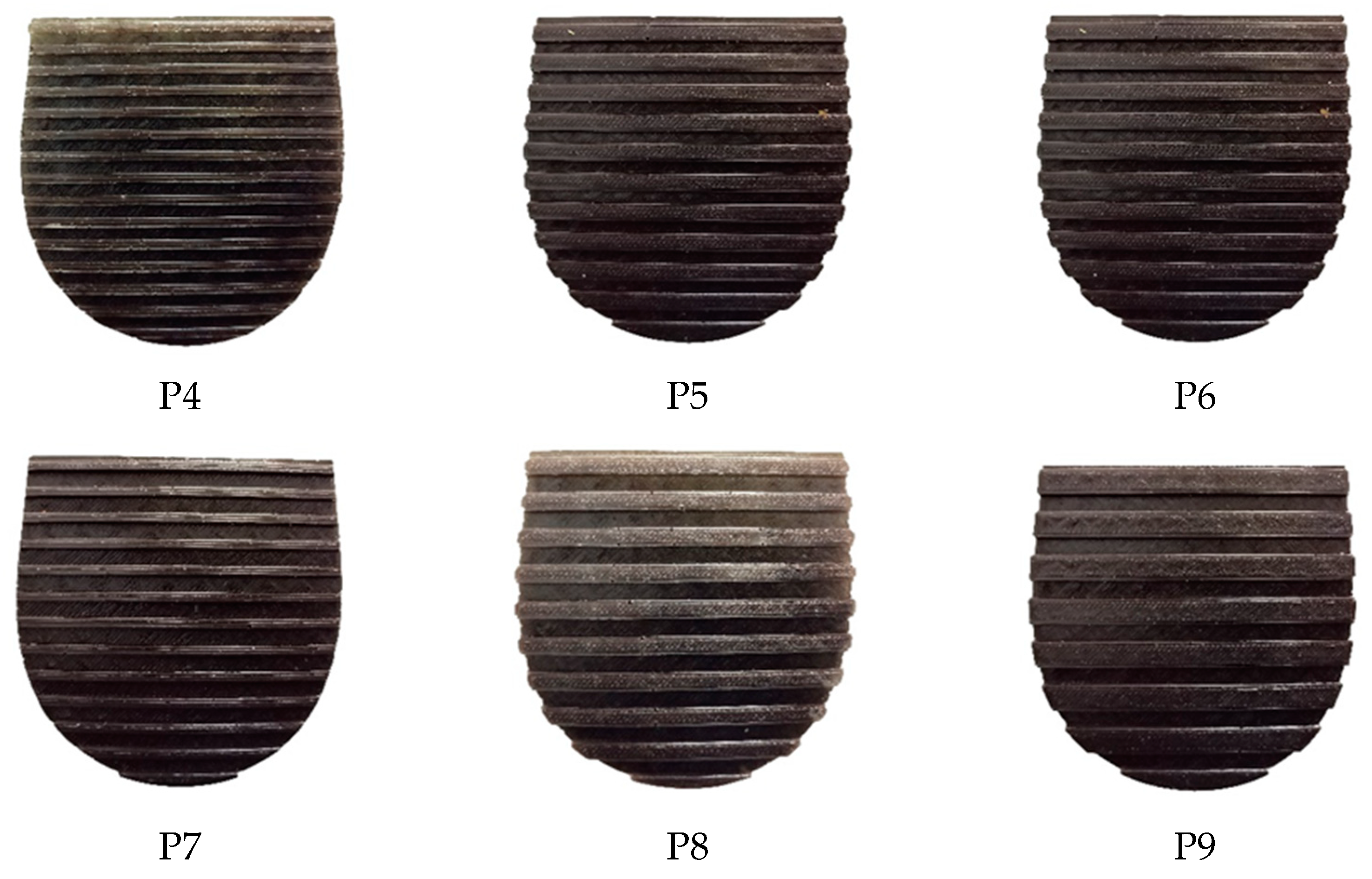

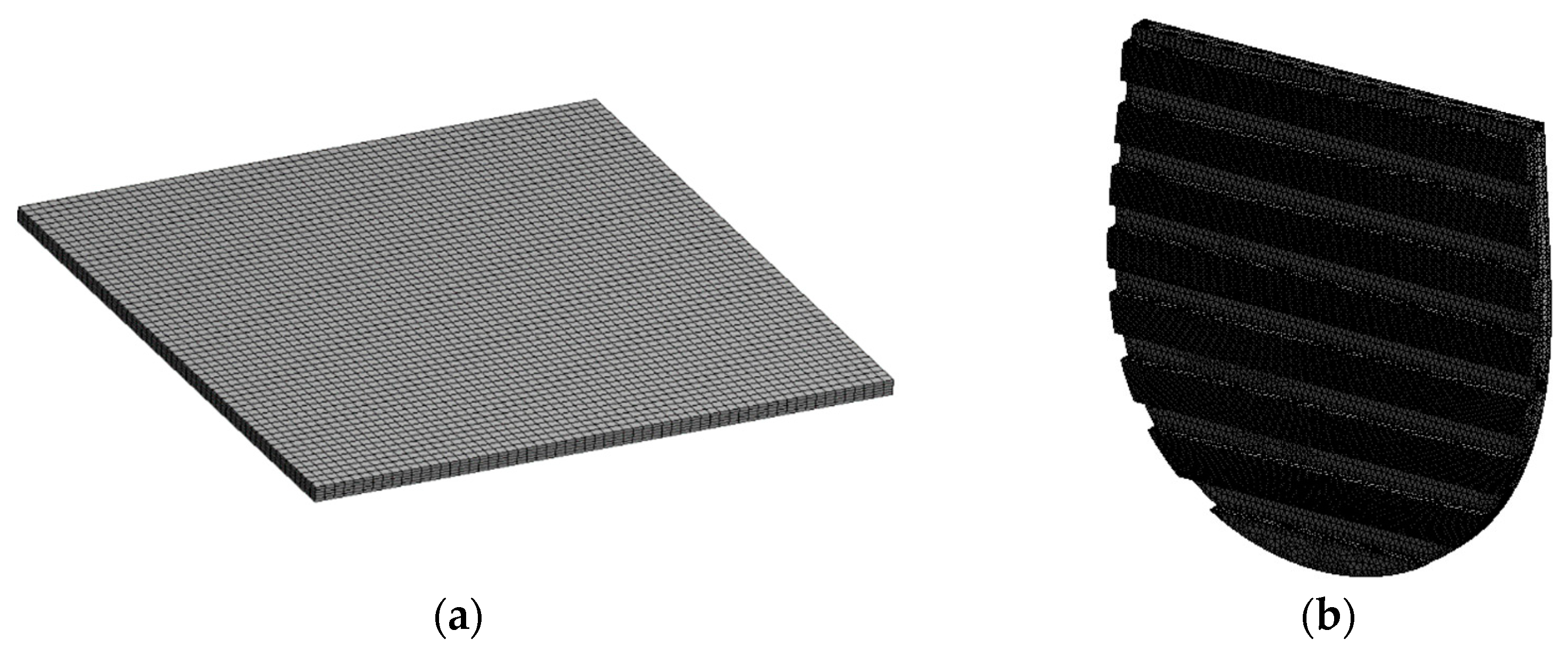

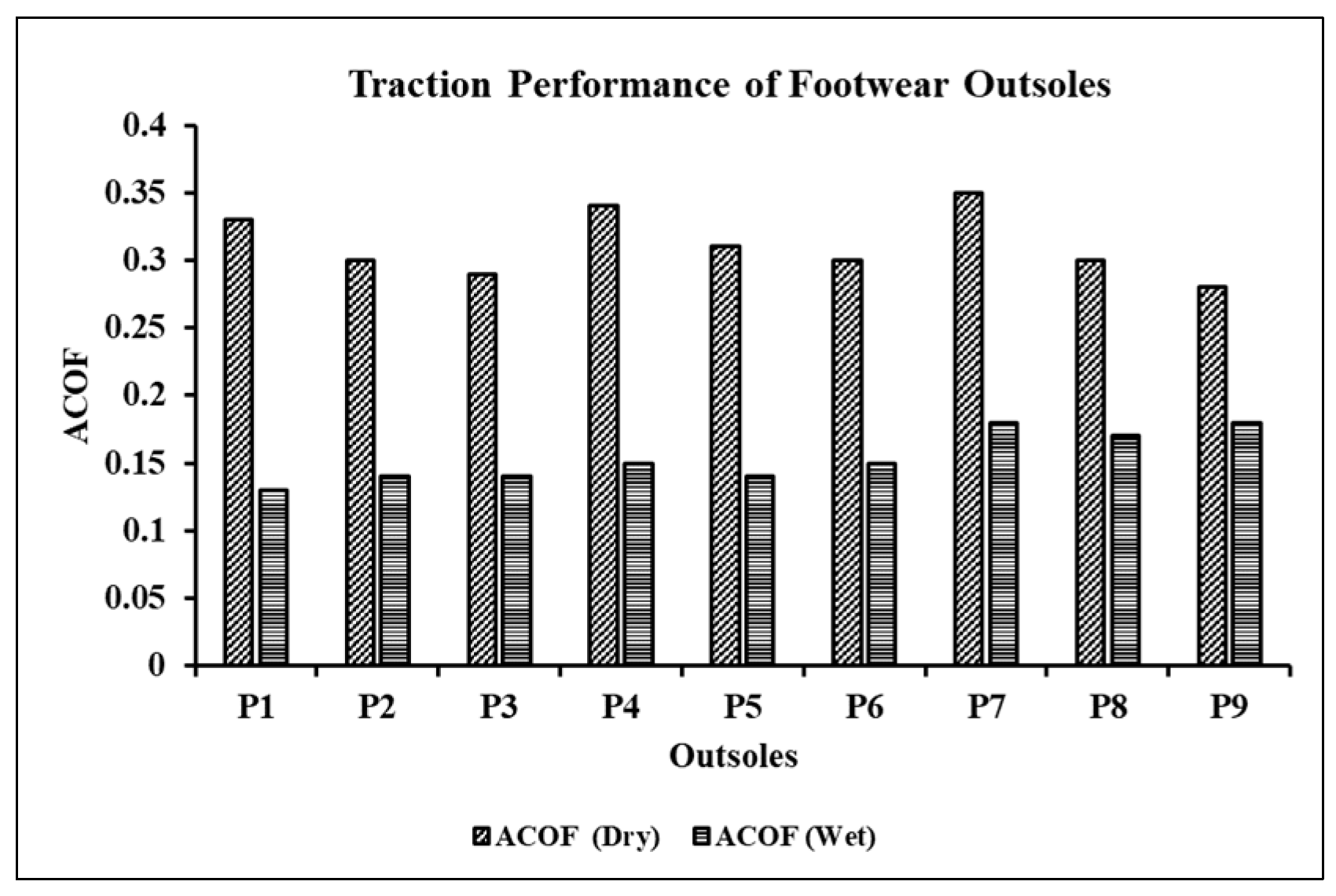
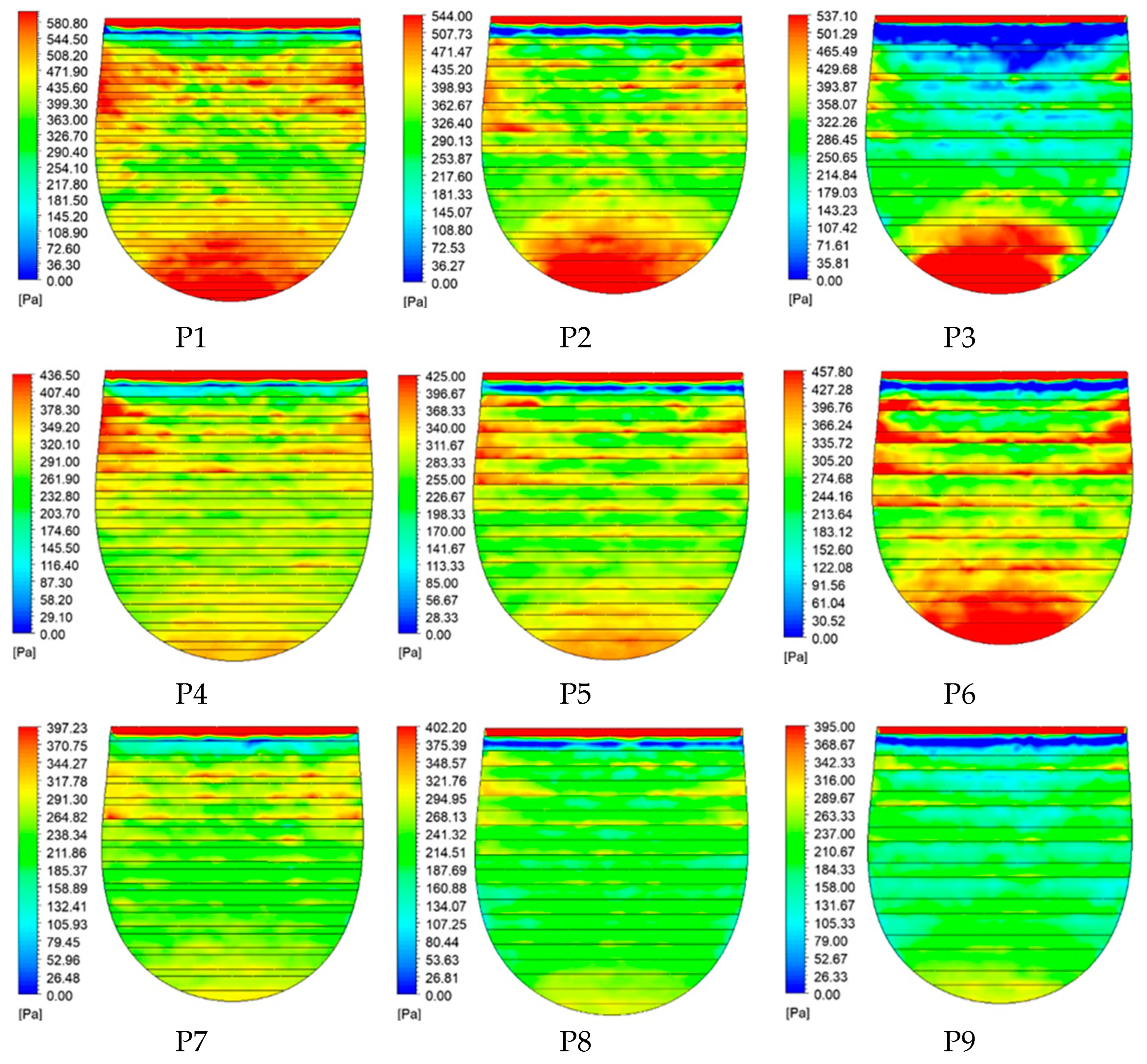



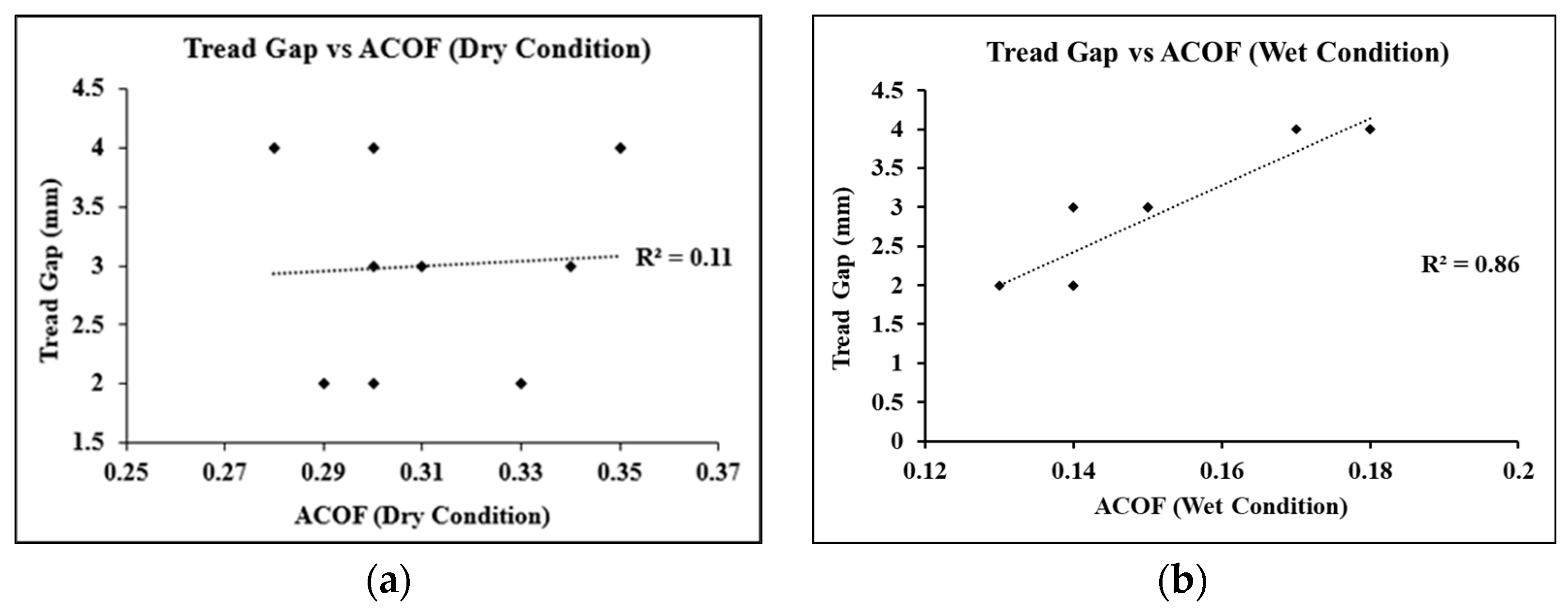

| Outsole Nomenclature | Width (mm) | Gap (mm) |
|---|---|---|
| P1 | 2 | 2 |
| P2 | 4 | 2 |
| P3 | 6 | 2 |
| P4 | 2 | 3 |
| P5 | 4 | 3 |
| P6 | 6 | 3 |
| P7 | 2 | 4 |
| P8 | 4 | 4 |
| P9 | 6 | 4 |
Disclaimer/Publisher’s Note: The statements, opinions and data contained in all publications are solely those of the individual author(s) and contributor(s) and not of MDPI and/or the editor(s). MDPI and/or the editor(s) disclaim responsibility for any injury to people or property resulting from any ideas, methods, instructions or products referred to in the content. |
© 2023 by the authors. Licensee MDPI, Basel, Switzerland. This article is an open access article distributed under the terms and conditions of the Creative Commons Attribution (CC BY) license (https://creativecommons.org/licenses/by/4.0/).
Share and Cite
Gupta, S.; Chatterjee, S.; Malviya, A.; Singh, G.; Chanda, A. A Novel Computational Model for Traction Performance Characterization of Footwear Outsoles with Horizontal Tread Channels. Computation 2023, 11, 23. https://doi.org/10.3390/computation11020023
Gupta S, Chatterjee S, Malviya A, Singh G, Chanda A. A Novel Computational Model for Traction Performance Characterization of Footwear Outsoles with Horizontal Tread Channels. Computation. 2023; 11(2):23. https://doi.org/10.3390/computation11020023
Chicago/Turabian StyleGupta, Shubham, Subhodip Chatterjee, Ayush Malviya, Gurpreet Singh, and Arnab Chanda. 2023. "A Novel Computational Model for Traction Performance Characterization of Footwear Outsoles with Horizontal Tread Channels" Computation 11, no. 2: 23. https://doi.org/10.3390/computation11020023
APA StyleGupta, S., Chatterjee, S., Malviya, A., Singh, G., & Chanda, A. (2023). A Novel Computational Model for Traction Performance Characterization of Footwear Outsoles with Horizontal Tread Channels. Computation, 11(2), 23. https://doi.org/10.3390/computation11020023








